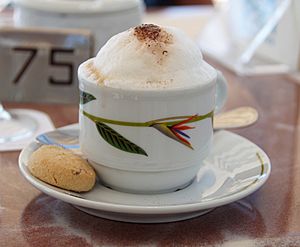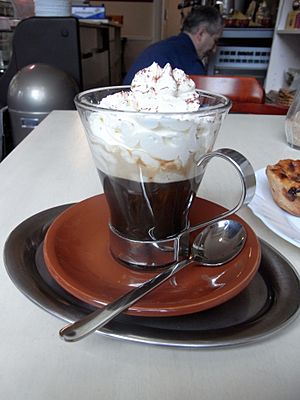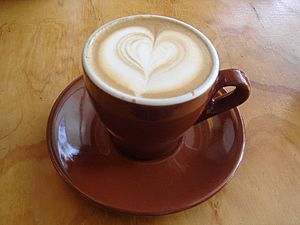Cappuccino facts for kids
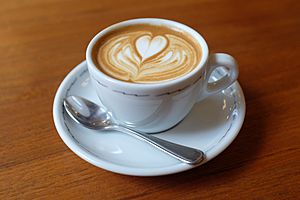
Cappuccino
|
|
| Type | Hot |
|---|---|
| Country of origin | Italy |
| Introduced | Approx. 17th century (beverage) |
| Colour | Black, dark brown, beige, light brown, white |
A cappuccino (![]() i/ˌkæpʊˈtʃ[unsupported input]oʊ/; Italian pronunciation: [kapputˈtʃiːno]) is a popular coffee drink that comes from Italy. It's made with a shot of strong coffee called espresso, and then topped with hot, foamy milk.
i/ˌkæpʊˈtʃ[unsupported input]oʊ/; Italian pronunciation: [kapputˈtʃiːno]) is a popular coffee drink that comes from Italy. It's made with a shot of strong coffee called espresso, and then topped with hot, foamy milk.
Sometimes, people make cappuccinos with cream instead of milk. They might also use milk substitutes or add flavors like cinnamon or chocolate powder. A cappuccino is usually smaller than a caffè latte. It also has a thicker layer of milk foam.
The name "cappuccino" comes from the Capuchin friars. Their brown robes were a similar color to the drink when milk was added to dark coffee. The cappuccino we know today, with its espresso and steamed milk, has changed a lot over time.
Contents
What is a Cappuccino?
Outside of Italy, a cappuccino is a coffee drink with a single shot of espresso and hot milk. The top is covered with foamed milk. Cappuccinos are usually made using an espresso machine.
First, the espresso is poured into the cup. Then, a similar amount of hot milk is added. This milk is heated and frothed using the espresso machine's steam wand. The top part of the drink is milk foam. Sometimes, baristas (coffee makers) create cool designs on the foam. This is called latte art.
In traditional coffee shops in Europe and the US, a cappuccino is usually between 150 and 180 ml (5 and 6 imp fl oz; 5 and 6 US fl oz) in total. However, some larger coffee chains in the US serve much bigger cappuccinos, sometimes 360 ml (13 imp fl oz; 12 US fl oz) or more.
In Italy, a cappuccino has 25 ml (1 imp fl oz; 1 US fl oz) of espresso. The rest of the cup is filled with equal parts milk and foam. Outside Italy, the drink is often made with one-third espresso, one-third milk, and one-third foam.
A traditional cappuccino is small, about 180 ml (6 imp fl oz; 6 US fl oz) maximum. It has a thick layer of foam. A "latte" is usually larger, around 200 to 300 ml (7 to 11 imp fl oz; 7 to 10 US fl oz). Lattes are often served in a tall glass, while cappuccinos come in a smaller cup with a handle.
Cappuccinos should have a layer of textured milk foam that is at least 1 cm (0 in) thick. This special foam is called "microfoam." It has tiny bubbles that make the milk light and thick. This microfoam stays on top of the drink and mixes well with the coffee.
The World Barista Championship is a competition held every year. Baristas must make four cappuccinos for the judges. These cappuccinos must have a good balance of sweet milk and espresso. They need one shot of espresso, textured milk, and foam. The foam must be at least 1 cm (0 in) deep. The total volume of the drink should be between 150 ml (5 imp fl oz; 5 US fl oz) and 180 ml (6 imp fl oz; 6 US fl oz).
Where the Name Comes From
The word 'Cappuccino' comes from the Latin word Caputium. This word was later used in German/Austrian and changed to Kapuziner. In Italian, cappuccino is a small version of cappuccio, which means "hood." So, cappuccino literally means "small hood."
The coffee drink got its name not from a hood, but from the color of the hooded robes worn by the Capuchin monks and nuns. This color was a distinctive reddish-brown. In the 17th century, "capuchin" was a common way to describe this color.
The Capuchin monks chose the design and color of their robes in the 16th century. They were inspired by the clothes worn by Francis of Assisi in the 13th century. The monks' long, pointed hood gave them the nickname "capuchins" (hood-wearers). However, it was the reddish-brown color of their robes that led to "capuchin" being used as a color name.
The Italian word cappuccino for the drink wasn't commonly used in writing until the 20th century. But the German word Kapuziner was mentioned as a coffee drink in Austria in the 18th century. Dictionaries from 1800 onwards described it as "coffee with sugar, egg yolks, and cream." Before World War I, Kapuziner was a common coffee drink in cafés in northern Italy that were part of Austria.
Using fresh milk in coffee at cafés is a newer trend, becoming common in the 20th century when refrigerators became widespread. Cream was used much earlier, as it was easier to store. A Kapuziner was made with a small amount of cream to get the "capuchin" color. Today, Kapuziner is still served in traditional Viennese cafés. It's black coffee with just a few drops of cream, or sometimes a dollop of whipped cream.
How Cappuccino Evolved
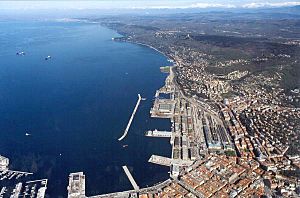
When coffee first came to Europe, it was made the way people in the Ottoman Empire did. They boiled coffee and water together, sometimes adding sugar. By the 19th century, people in Europe started brewing coffee in different ways, using special devices.
Adding milk to coffee was mentioned by Europeans as early as the 1700s. The cappuccino started as the "kapuziner" coffee in Viennese coffee houses in the 1700s. Around this time, kapuziner appeared on coffee house menus across the Habsburg monarchy. In 1805, a dictionary described it as "coffee with cream and sugar."
Kapuziner was mentioned again in the 1850s as "coffee with cream, spices, and sugar." Other coffees with cream also appeared in Vienna. Outside Austria, these were called "Viennese coffee" or "café Viennois." These were coffees with whipped cream on top.
The Kapuziner coffee got its name from the color of coffee with a few drops of cream. This color reminded people of the Capuchin monks' robes. Another popular coffee was Franziskaner, which had more cream. This referred to the lighter brown color of the robes of Franciscan monks. Kapuziner coffee spread throughout Central Europe, including Italian-speaking areas that were part of the Habsburg monarchy. The city of Trieste, a major port, already had many Viennese coffee houses.
The word "cappuccino" (in Italian) first appeared in northern Italy in the 1930s. Photos from that time show the drink looking like "Viennese" coffee. This was coffee topped with whipped cream and sprinkled with cinnamon or chocolate. The Italian cappuccino changed over the next few decades. Steamed milk on top was added later.
After World War II, espresso machines became common in Italy during the 1950s. The definition of "cappuccino" changed. It was now made from espresso and frothed milk. As espresso machines got better, so did the way coffee was measured and milk was heated. Outside Italy, cappuccino spread, but it was often still made with dark coffee and whipped cream.
Espresso machines were first invented in the early 1900s. Luigi Bezzera of Milan filed the first patent in 1901. However, these early machines didn't make espresso the way we know it today.
Coffee making in cafés changed a lot in the early 20th century. The first machines allowed cafés to make espresso specifically for each customer. The cups were still the same size, and the coffee beans were ground coarsely. The high temperature of the boilers often burned the coffee. Many attempts were made to improve this after World War I.
After World War II, Italians introduced the "age of crema." New coffee machines could create higher pressure. This led to a finer grind and the classic crema (the reddish-brown foam on top of espresso).
The first small cups for espresso appeared in the 1950s. By then, machines could also heat milk. This is how the modern cappuccino was born. In Vienna, espresso bars opened in the 1950s. Both the old kapuziner and the new Italian cappuccino were served side-by-side.
In the United Kingdom, espresso coffee became popular as cappuccino. This was partly because British people liked drinking coffee with milk. They also enjoyed the unique texture of the drink.
In the United States, cappuccino became popular in Italian American neighborhoods. These included Boston's North End, New York's Little Italy, and San Francisco's North Beach. Caffe Reggio in New York City (founded 1927) claims to have brought cappuccino to the US. Caffe Trieste in San Francisco (founded 1956) claims to have brought it to the West Coast. An older place, Tosca Cafe in San Francisco (founded 1919), served a "cappuccino" earlier. But this drink had no coffee. It was made with chocolate, steamed milk, and brandy.
What's in a Cappuccino?
Today, a cappuccino is made with a single shot of espresso. The most important parts are the texture and temperature of the milk. When a barista steams the milk, they create microfoam. This is done by adding tiny air bubbles to the milk. This makes the milk feel smooth and velvety.
A traditional cappuccino has one espresso shot. The barista then pours hot, foamed milk on top. This creates a milk foam layer about 2 cm (3⁄4 in) thick. Sometimes, people add another shot of espresso to make a double cappuccino.
Making the right amount of foam needs careful attention when steaming the milk. This makes cappuccino one of the hardest espresso drinks to make perfectly. A skilled barista can even make artistic shapes (latte art) when pouring the milk.
How Popular is Cappuccino?
Cappuccino was traditionally very popular in Europe, Australia, South America, and parts of North America. By the mid-1990s, more fancy coffee shops opened in North America. This made cappuccino much more available there.
In Italy and across Europe, people traditionally drink cappuccino in the morning. It's usually part of breakfast, often with a pastry. Italians generally don't drink cappuccino with meals other than breakfast. They often drink espresso after lunch or dinner. In Italy, cappuccino is usually enjoyed before 11:00 a.m. This is because it's a milk-based drink and considered too heavy for later in the day. Espresso is preferred after meals because people believe it helps with digestion.
In North America, cappuccinos became very popular in the late 1990s and early 2000s. This was especially true in cities like those in the urban Pacific Northwest.
Cappuccinos are traditionally served in cups that hold 150–180 ml (5–6 imp fl oz; 5–6 US fl oz). However, by the early 2000s, some fast-food chains started serving much larger versions, sometimes up to 600 ml (21 imp fl oz; 20 US fl oz).
How to Make a Cappuccino
Traditional and Latte Art
Cappuccinos can vary in size, but there are two main ways to prepare them. One is the traditional or classical way, with a cap of milk foam. The other is the "latte art" way.
The traditional method follows the idea of one-third espresso, one-third steamed milk, and one-third milk foam. The latte art method uses the same recipe. However, it's often served in smaller cups. The textured milk is carefully poured to create a pattern on the coffee's surface. The pictures in this article show these different ways of making a cappuccino.
Cold Cappuccinos
There are also cold versions of cappuccino.
Cappuccino Freddo
Cappuccino Freddo is the cold version of a cappuccino. It usually has a small amount of cold frothed milk on top. This drink is popular in Greece, Cyprus, and some parts of Italy.
In Rome, coffee bars often have this drink already made and chilled. In cities like Milan in Northern Italy, Cappuccino Freddo is less common. Instead, people prefer gelato da bere (a thick mix of gelato and espresso) or shakerato (espresso shaken with ice). The name "Cappuccino Freddo" has also spread around the Mediterranean region. Here, foam is added just before serving, and it might be different from the Italian original. A caffè freddo or freddo espresso is a cold version of an espresso without milk.
In North America, "Cappuccino Freddo" or "Iced cappuccino" might not always have the special frothed milk. For example, at Starbucks, if it doesn't have the frothed milk, it's called an "iced latte."
Freddo Cappuccino
In Greece and Cyprus, a cold cappuccino is widely known as Freddo Cappuccino. This is different from Cappuccino Freddo. Despite its Italian name, this drink tastes and is made differently from the Italian version. It's not common outside Greece.
The Freddo Cappuccino is topped with a cold milk foam called afrógala (Greek: αφρόγαλα). This foam is made by blending cold milk with an electric frother. These frothers are common in Greek coffee shops because they are also used to make frappé coffee. The foam is then added to espresso poured over ice.
Along with the Freddo Espresso, these drinks were created in Greece in 1991. They are very popular in the summer. Outside Greece and Cyprus, Freddo Cappuccino is mostly found in coffee shops that serve the Greek community. In 2017, Starbucks added the Cappuccino Freddo to its menus in Europe.
Iced Capps
In Canada, the Tim Hortons coffee chain sells an iced coffee cappuccino called Iced Capps. This drink mix comes to the stores as a thick syrup. It's mixed with water in a Slurpee machine. The frozen coffee drink is then blended with cream when served. Customers can also ask for it with milk or chocolate milk. The Ice Capp can also be made as a "Supreme." This includes a flavor shot, whipped topping, and caramel or chocolate syrup. Tim Hortons also sells regular iced coffee in Canada and the U.S.
Similar Drinks
There are other coffee drinks with milk that are similar to a cappuccino:
- Caffè macchiato (sometimes called espresso macchiato) is a much smaller drink. It's espresso with only a tiny bit of milk.
- Cortado is a Spanish drink. It's a bit smaller than a cappuccino. It has espresso mixed with milk, usually in a 1:1 or 1:2 ratio. It doesn't have foam on top. Traditionally, it was served in a small glass. Its unique taste comes from the Spanish coffee beans and condensed milk instead of fresh milk. Modern coffee shops now use fresh milk.
- Flat white is a popular drink in Australia and New Zealand. It's somewhere between a cappuccino and a caffè latte. "Flat" means it has little or no foam. It's usually made with a double shot of espresso and a little latte art on top. A flat white uses a milder espresso and no robusta coffee beans.
- Latte (short for "caffè latte") is a larger drink. It has the same amount of espresso as a cappuccino, but much more milk and a different amount of foam. It's served in a large cup or tall glass.
- Steamer or babyccino is a drink of frothed milk without coffee. So, it has no caffeine. In the United States, it often has flavored syrup added. In other countries, it often has a dusting of cocoa powder.
Images for kids
-
The old port of Trieste where most of the coffee for Central Europe was handled for a long time and from where the cappuccino spread.
See also
 In Spanish: Capuchino (café) para niños
In Spanish: Capuchino (café) para niños


